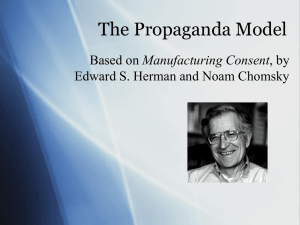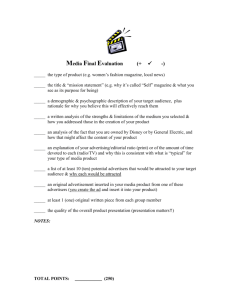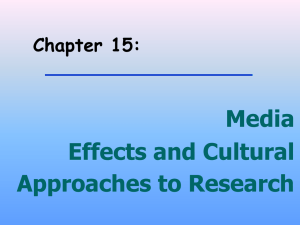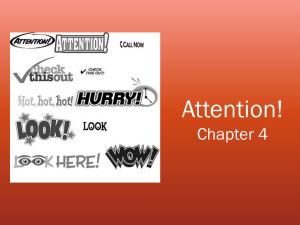MCOM 409: Mass Communication Theories
advertisement
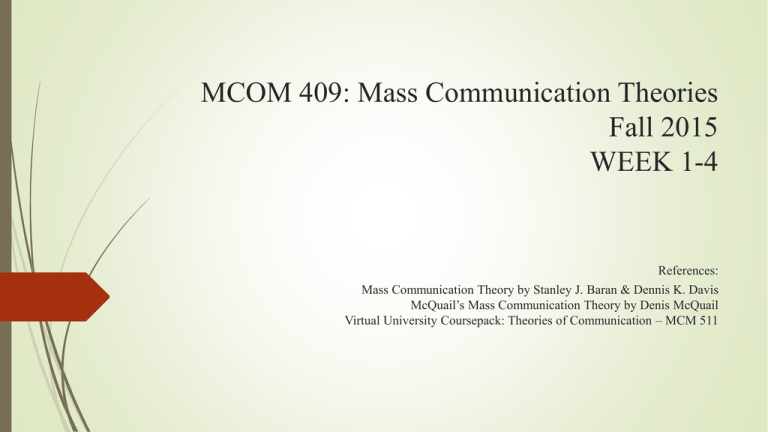
MCOM 409: Mass Communication Theories Fall 2015 WEEK 1-4 References: Mass Communication Theory by Stanley J. Baran & Dennis K. Davis McQuail’s Mass Communication Theory by Denis McQuail Virtual University Coursepack: Theories of Communication – MCM 511 Theory, Model and Paradigm Theory Jonathan H. Turner defined theory as a process of developing ideas that can allow us to explain how and why events occur. Theories help us understand or explain phenomena we observe in the social world. Example: If we feel media instruct us what to and how to think about certain issues-The phenomenon has been theorized as Agenda Setting Theory Model Models are a theoretical and simplified representation of a phenomenon. Example: Basic Model of Communication (Sender Message Channel Receiver) Paradigm Paradigm is a whole system of thinking. “A paradigm is a set of beliefs, values techniques which are shared by members of a scientific community, and which acts as a guide or map dictating the kinds of problems scientist should address and the types of explanation that are acceptable”. (Kuhn, 1970) Approaches to define theory A) Stipulative Approach: By setting forth a group of characteristics that must be present in any theory. (Restrictive Approach) B)Reportive Approach: By looking at entities that have been called theories in the past analyzing the nature of entities. (Inclusive Approach) Functions of Theory Types of Functions: A) Empirical Problem Solving: Anything about the…. world which strikes us odd, or otherwise in need of an explanation. Example: Why do interactants of western Culture behave differently as compared to interactants of Eastern Culture? B) Conceptual Problem Solving: The conceptual problem can be internal or external. An internal problem exists when a particular theory exhibits inconsistencies that need to be clarified. Example: Marshal McLuhan-Media Ecology External Problem: A particular theory conflicts with an explanation provided by another theory. Example: Theories of Media Effect contradicting each other. Functions of Theories..Cont’ C)Practical Problem Solving: Highlights the role of a theory is solving practical problems Example: Persuasive Campaigns to promote desirable behavior Normative Media Theories What should be the role of Media in Society Media Freedom v/s Media Control Authoritarian Theory An idea that placed all forms of communication under the governing elites or authorities. Governing Elites are exercising the control to maintain social order. Libertarian Theory There should be no law governing media operations. All forms of media must be totally un regulated Totalitarian Theory: Direct control of the media by Dominant political party was seen as essential to prevent deviant, disruptive views from being expressed by enemies of the people. Social Responsibility Theory Media’s Obligations to society. Commitment to truth, accuracy, objectivity and balance Self Regulations Avoid coverage leading to crime, violence, civil disobedience Support diversity, should have a pluralistic approach High standards of performance Accountable to society Introduction to Mass Society Context of Theory Societal Transformations (in the middle of 19th), Attributed to industrialization Urbanization New Media technologies and Industrial advancement Emergence of mass democracy Characteristics of traditional and mass societies Shift from traditional communities to a ‘mass society’. Traditional Societies: Individuals have strong local and social ties Mass Society: Individuals grown isolated and much vulnerable to manipulation or persuasion by new emerging mass political movements and mass media. Apprehension about mass media New technology will disrupt peaceful communities Mass Media symbolized everything that was wrong with urban life Media lowered class tastes Brings Political unrest Characteristics of Mass Society and Mass Audience Large number Widely dispersed Non-Interactive and anonymous Heterogeneous Not Organized Postulates of Mass Society Theory Media is a cancerous force must be restructured Media have power to reach out and directly influence minds of people. Average people are helpless, violence on TV and Children. Heavy Metal Music and Teenagers Once Minds are corrupted, result in long term and short term consequences Drug addictions, dissatisfaction, delinquency The Social Chaos initiated by Media will be resolved by Totalitarianism, Mass Society is envisioned as a chaotic, highly unstable social order that will collapse and replace by Totalitarianism. Debase Higher Cultural Forms Glorify Gangsters Why not religious leaders and Great Educationists Why pander to popular taste. How teachers are portrayed. Discarding Religion. Reinforcing Stereotype-Rigid Father and Hypocrites Decline in the role of mothers Propaganda Theories Walter Lippman Theory: Question the ability of average people to analyze media messages Average people can not govern themselves Public is vulnerable to propaganda Information gathering and distribution should be in hands of scientific class; promoted idea of scientific technocrats Magic Bullet Theory In the 1920s Media was assumed to operate like magic bullets that penetrated people’s minds and instantly created associations between strong emotions and specific concepts. By carefully controlling these magic bullets, propagandists felt that they could condition people associate good emotions, such as loyalty and reverences with their own country and associate bad emotions, such as fear and loathing with their enemies. LASSWELL’S PROPAGANDA THEORY. Propaganda was not so much the result of the substance or appeal of specific messages but rather the result of the vulnerable state to mind of average people. He argued that economic depression and escalating political conflict had induced widespread psychosis (hang up, obsession)and this made people susceptible to even crude forms of propaganda he rejected simplistic magic bullet theory . Herman and Chomsky propaganda model Inequality of wealth and power and its multi level effects on mass media interests and Choices Filter 01. Size, Ownership and Profit Orientation of Mass Media Increased Media Concentrations and Expansions Media Companies are integrated in to the market Stocks have become market favorite Increased pressure and temptation to focus profitability. Cross Ownerships/Non-Media Owners The control groups of media giants Having close relationships with other corporate Taking care of their financial interests Preferring corporate community Dependence on the Government Licenses and franchises Legal/Technical Dependency Seeking Policy Support Favorable taxation, interest, labor and audit policies Diplomatic Support to penetrate foreign cultures Filter 02: Advertising Competition for advertisers to cover production costs Media tactics to attract advertisers Maximizing Audience Delivery Media help advertisers optimize the effectiveness of their network by evaluating audience segments in proportion to usage level of advertisers’ products and services Media Subsidy Advertisers are patrons who provide media subsidy. Developing specialized staff to solicit advertisers, explaining how their programs serve advertisers interest. Aspire to be an Advertising-Friendly Medium Promote congeniality for buying and consumption, stress people to consume Advertisers influence editorial policies, and content of the channels Fears of withdrawal from Sponsorships WNET lost funding from Gulf + Western after station broadcasted the documentary “Hungry for Profit” contain content critical of multinational corporate activities Filter 03: Sources Relying on the official sources/ Powerful Sources Information is usually have a spin on it and Managed Dependency on the official sources Threats and Rewards further influence the role of journalists and sources Filter 04: FLAK The fourth filter is 'flak', described by Herman and Chomsky as 'negative responses to a media statement or [TV or radio] program. It may take the form of letters, telegrams, phone calls, petitions, law-suits, speeches and Bills, and other modes of complaint, threat and punitive action'. PEMRA’s allegation against “Zara sochiye campaign” Legal Action against “ARY News” for broadcasting the objectionable video of Ziarat Residency provided by Outlawed outfit Filter 05: Political Control Mechanism Anti-Terrorism control mechanism reaches through the system to exercise a profound influence on the mass media. Issues tend to be framed in terms of a dichotomization world of terrorists and antiterrorists
